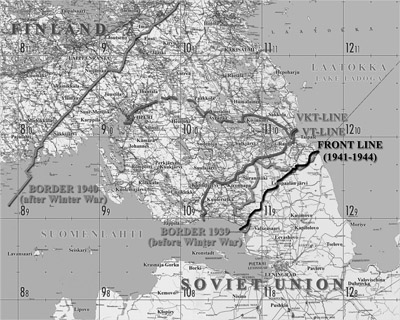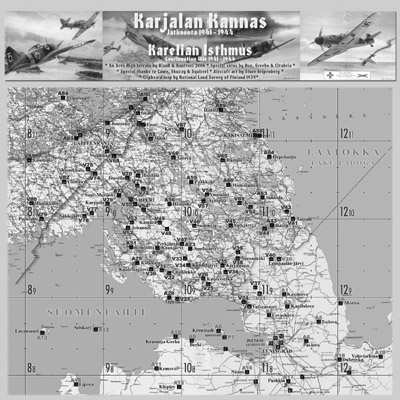
Historical Background
Following the successes against the Germans during 1943 and the beginning of 1944, Soviet Union launched the fourth of its ten strategic attacks on June 9th 1944, north east of Leningrad. The largest Soviet offensive of 1944 was timed to support of the western allies, who had landed in Normandy three days earlier. The objective of the Soviet attack was to force Finland out of the war and ultimately conquer it.
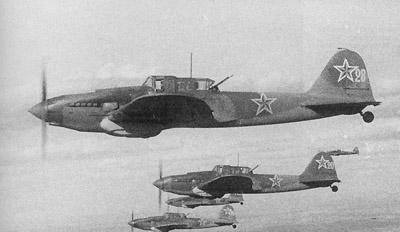
Russian IL2 Sturmoviks were feared aircrafts among Finnish
infantry troops. They called that plane as "Maatalouskone"
("Farming Machine").
______
The Soviet Air Force (VVS) threw a formidable force against the Finns. 'The Great Attack', as it became known in Finland, was supported by more than 250 bombers and 1000 fighter- and strike aircraft from Lt.General Rybaltschenko's 13th Air Army (13 VA), with a further 220 from the Soviet Red Banner Baltic Fleet Air Force (VVS KBF). The Soviets had over 1500 aircraft supporting the ground attack wedge, not more than 20 kilometers wide at any given point.
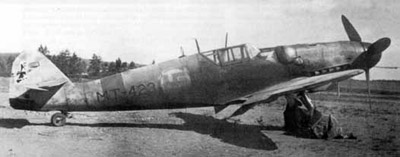
A Finnish Bf 109 G2's and G6's were the best fighter they had
in the Continuation War. Bf 109's Finnish nickname was
"Mersu", Russians called it as "Messer".
______
Opposing the Soviet armada over the Karelian Isthmus were Lt.Colonel Magnusson's Flight Regiment 3 (LeR 3) and Lt.Colonel Joensuu's Flight Regiment 4 (LeR 4) of the Finnish Air Force. Equipped with only 30 Messerschmitt 109 G's, 18 Brewsters and 53 bombers, of which only 12 were modern Ju 88's, the Finns faced even worse odds than during the Winter War four years earlier.
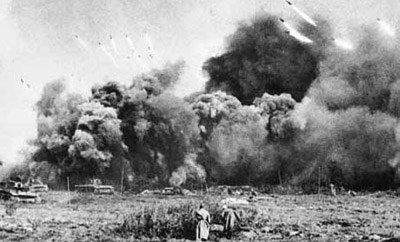
"Stalin's organ" in the action. These Russian rocket missiles
were very destructive weapons.
______
Also on the ground, the Soviet Union enjoyed a superiority both in numbers and the quality of equipment. During the spring months, the Soviets had made meticulous preparations and had 270 000 men, 1800 artillery pieces and 600 tanks in attack positions. Across the border in poorly fortified installations the 70 000 Finnish defenders, equipped with 300 artillery pieces, 100 tanks and practically no anti-tank weapons, were ill prepared for the upcoming onslaught. Battle-hardened during 3 years of fighting against Germany, the Soviet armed forces posed a serious threat to the existence of Finland as a nation.
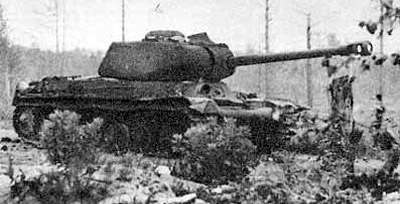
Russian T-34 tank in a forest somewhere in the Karelian Isthmus.
The Finnish Army had also couple of these, captured and
repaired from the Russians. The Finnish terrain is not very
suitable for tanks, lots of dense forests forced the tanks to
the few roads and railroads. This made them a lot more vulnerable
to infantry anti-tank weapons than in the vast open areas of'
Middle Europe.
______
As the Soviet attack begun, the Finns immediately contacted Germany and sent a desperate request for help. Germany agreed to sell more Messerschmitts and anti-tank infantry weapons to the Finnish armed forces. In addition, German combat units were sent to Finland. Less than a week after the attack had begun, Gefechtsverband Kuhlmey arrived, a Luftwaffe combat group consisting of some 70 Stukas and Focke Wulf jabos, more than doubling the ground attack capability of the Finnish Air Force. In addition, several German infantry and tank units arrived to help in the struggle to maintain Finland's independence.
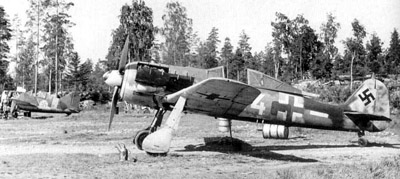
German Focke Wulf FW 190 A-6 fighters escorted the Detachment
Kuhlmey's Stukas and FW 190 F-8 jabos. This German unit
helped Finland very much when the Soviet's Great Offensive
was on its worst during June and July 1944. Detachment
Kuhlmey's home base were Immola airfield.
______
On the Karelian Isthmus, the Finns had three main defensive lines: the main line, VT-line and VKT-line. The main defensive positions on the border were in many places poor, with the terrain giving no natural cover for the defenders. The Vammelsuu-Taipale (VT) -line was the first well fortified position, located approximately 20 kilometers from the frontline. The fortifications of the Viipuri-Kuparsaari-Taipale (VKT) -line had only started and were still unfinished, but the rocky terrain at the VKT-line favoured the defender.
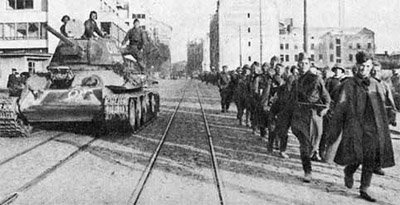
Russian tanks and troops marching into Viipuri in June 1944.
The loss of this old Finnish town was a serious defeat to the
Finnish Army.
______
The flat landscape and good roads of the western Karelian Isthmus favoured the attacker's mobile units and heavy use of tanks. Breaking through the VKT-line would open a direct passage to the southeastern plains and all the way to Helsinki, the capital of Finland...
__________________________________________________
Maps
The map of the Karelian Isthmus. Click to enlarge.
______
__________________________________________________
Scenario's Timetable
Dates
* Registration begins on Wednesday 1st of March 2006.
* BETA FRAME Saturday 25th of March 15.00 EST 20.00 UK
* FRAME 1 Saturday 1st of April 15.00 EST 20.00 UK
* FRAME 2 Saturday 8th of April 15.00 EST 20.00 UK
* FRAME 3 Saturday 15st of April 15.00 EST 20.00 UK
* FRAME 4 Saturday 22nd of April 15.00 EST 20.00 UK
Additional Rules Sections
__________________________________________________
Movie trailers
Stalin's
Fourth Video 1 by Have
Stalin's
Fourth Video 2 by Mipoikel
Credits
Scenario design: the Finns
Allied CO: Drano
Axis CO: Mipoikel
